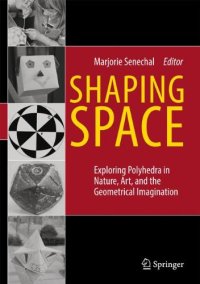
Ebook: Shaping Space: Exploring Polyhedra in Nature, Art, and the Geometrical Imagination
- Tags: Geometry, Crystallography, Design general
- Year: 2013
- Publisher: Springer-Verlag New York
- Edition: 1
- Language: English
- pdf
Molecules, galaxies, art galleries, sculptures, viruses, crystals, architecture, and more: Shaping Space—Exploring Polyhedra in Nature, Art, and the Geometrical Imagination is an exuberant survey of polyhedra and at the same time a hands-on, mind-boggling introduction to one of the oldest and most fascinating branches of mathematics.
Some of the world’s leading geometers present a treasury of ideas, history, and culture to make the beauty of polyhedra accessible to students, teachers, polyhedra hobbyists, and professionals such as architects and designers, painters and sculptors, biologists and chemists, crystallographers, physicists and earth scientists, engineers and model builders, mathematicians and computer scientists.
The creative chapters by more than 25 authors explore almost every imaginable side of polyhedra. From the beauty of natural forms to the monumental constructions made by man, there is something to fascinate every reader. The book is dedicated to the memory of the legendary geometer H. S. M. Coxeter and the multifaceted design scientist Arthur L. Loeb.
This second edition is based off of the very popular Shaping Space: A Polyhedral Approach, first published twenty years ago. The book is expanded and updated to include new developments, including the revolutions in visualization and model-making that the computer has wrought.
Shaping Space is an exuberant, richly-illustrated, interdisciplinary guide to three-dimensional forms, focusing on the suprisingly diverse world of polyhedra. Geometry comes alive in Shaping Space, as a remarkable range of geometric ideas is explored and its centrality in our cultre is persuasively demonstrated. The book is addressed to designers, artists, architects, engineers, chemists, computer scientists, mathematicians, bioscientists, crystallographers, earth scientists, and teachers at all levels—in short, to all scholars and educators interested in, and working with, two- and three-dimensinal structures and patterns.